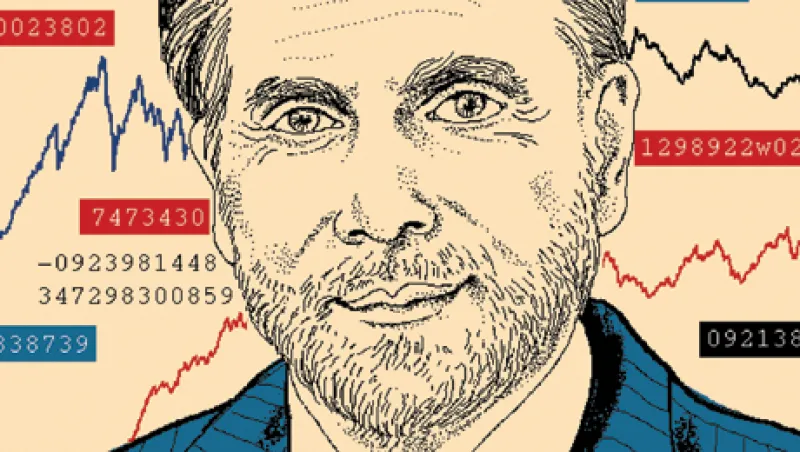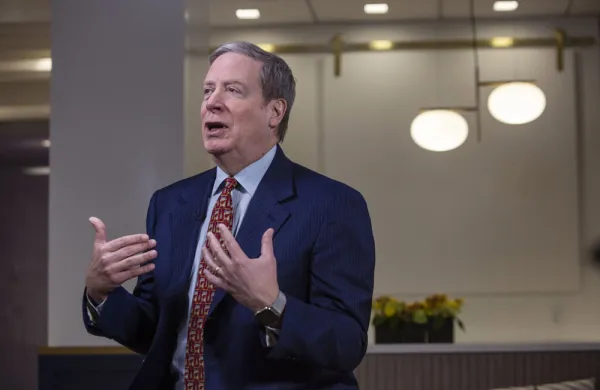The 2008 meltdown, its regulatory aftermath and residual shocks like the European debt crisis continue to constrain bank profits and capital market activity and cast a pall of austerity over many financial institutions. Yet excitement and optimism reign among the developers and managers of the technologies on which firms and markets increasingly depend.
This enthusiasm is a common thread running through the Tech 50, Institutional Investor's annual ranking of those who lead the financial services industry in technological achievement and innovation. Far from being oblivious to prevailing economic and competitive realities, these executives bear witness to them. Having risen in stature and influence well beyond where they were a generation or even a decade ago, they have a firm grasp of those challenges and bring to bear tools, resources and expertise critical to overcoming them.
"Technology isn't just about automation and efficiency," asserts Goldman Sachs Group chief information officer Steven Scopellite, No. 10 on the list. "We see it as a business enabler, an accelerator, a control point — a source of competitive advantage."
Adds Phupinder Gill (No. 16), CEO of CME Group: "Technology has been the great differentiator for us. Now we are a technology-based company."
Indeed, financial technology has come of age not only as a way to move manual tasks onto machines but also as an engine of profitability. Exchange operators CME, NYSE Euronext (Dominique Cerutti, No. 6), Nasdaq OMX Group (Robert Greifeld, No. 20) and London Stock Exchange Group (Antoine Shagoury, No. 37) all make money selling technology to other markets and are investing in growth opportunities, particularly in derivatives and clearing. Those thriving businesses sustain the No. 3 ranking of IntercontinentalExchange CEO Jeffrey Sprecher, who says proprietary technology is essential to ICE's ability "to maintain a healthy pace of product development."
| The 2012 Tech 50 Click name to view ranking profile. | |
| RANK | NAME / COMPANY |
| 1 | Thomas Secunda Bloomberg |
| 2 | Stephen Scullen III Fidelity Investments |
| 3 | Jeffrey Sprecher IntercontinentalExchange |
| 4 | Lance Uggla Markit Group |
| 5 | Catherine Bessant Bank of America Corp. |
| 6 | Dominique Cerutti NYSE Euronext |
| 7 | Michael Spencer ICAP |
| 8 | Guy Chiarello JPMorgan Chase & Co. |
| 9 | Olivier Le Grand Cortal Consors |
| 10 | Steven Scopellite Goldman Sachs Group |
| 11 | Dan Mathisson Credit Suisse |
| 12 | Daniel Coleman Getco |
| 13 | Robert Goldstein BlackRock Solutions |
| 14 | Seth Merrin Liquidnet Holdings |
| 15 | David Craig Thomson Reuters |
| 16 | Phupinder Gill CME Group |
| 17 | Sean O'Sullivan HSBC Holdings |
| 18 | Deborah Hopkins Citigroup |
| 19 | Joe Ratterman BATS Global Markets |
| 20 | Robert Greifeld Nasdaq OMX Group |
| 21 | Michael Bodson Depository Trust & Clearing Corp. |
| 22 | Gaurav Suri D.E. Shaw Group |
| 23 | William O'Brien Direct Edge |
| 24 | Lee Olesky Tradeweb Markets |
| 25 | Gerald O'Connell Chicago Board Options Exchange |
| 26 | Tom Miglis Citadel |
| 27 | Richard McVey MarketAxess Holdings |
| 28 | Ron Levi GFI Group |
| 29 | Lou Eccleston S&P Capital IQ |
| 30 | Marianne Brown Omgeo |
| 31 | Peter Carr Morgan Stanley |
| 32 | Magnus Böcker Singapore Exchange |
| 33 | Christopher Perretta State Street Corp. |
| 34 | David Gershon SuperDerivatives |
| 35 | Philip Weisberg FX Alliance |
| 36 | Jan Verplancke Standard Chartered |
| 37 | Antoine Shagoury London Stock Exchange Group |
| 38 | James Toffey Benchmark Solutions |
| 39 | John Bates Progress Software Corp. |
| 40 | |
| 41 | Bradley Peterson Charles Schwab Corp. |
| 42 | Gary Scholten Principal Financial Group |
| 43 | Steven Sadoff Knight Capital Group |
| 44 | Kim Fournais / Lars Seier Christensen Saxo Bank |
| 45 | Howard Lindzon StockTwits |
| 46 | Shin Kusunoki Nomura Research Institute |
| 47 | Robert Alexander Capital One Financial Corp. |
| 48 | Tyler Moeller Broadway Technology |
| 49 | R. Peter Sanchez Northern Trust Hedge Fund Services |
| 50 | Tyler Kim MaplesFS |
When budgets are tight, the typical mandate is to "do more with less." But thanks to performance gains — whether because of faster chips, programming advances like complex-event processing (see John Bates, No. 39 , and Mark Palmer, No. 40 ) or cloud computing utilities — technologists have more to work with. JPMorgan's Guy Chiarello (No. 8) points out that core technology costs are no greater than they were before the bank's acquisitions of failed Bear Stearns Cos. and Washington Mutual. Over three years JPMorgan has been able to shift $1.5 billion from "running the bank" to investing in product development and "new value for our customers," says Chiarello. "That's competitive advantage," he adds.
The top two on the Tech 50, Thomas Secunda and Stephen Scullen III, respectively represent privately held Bloomberg and Fidelity Investments, which do not disclose expenditures. They clearly play in the elite financial tech league and set standards to which others aspire.
When Bloomberg could not buy technology that met its specifications for data throughput and speed, the firm invented it. "We have unique problems, and only a few know how to solve them, so we often build our own technology," explains Secunda, global head of financial products and services. Bloomberg's 3,000 programmers, he says, "aren't there to support the existing system. They are there to dynamically and aggressively add new functions to our system so that we can continue to maintain the value." Secunda stresses that Bloomberg has a basic mission of serving customers, "and technology is a major part of that."
Scullen says it is much the same at Fidelity, where "we view technology as an investment, as opposed to an expense" and decisions come down to whether it adds value for the customer.
The giants have no exclusivity on focus and relentlessness. Secunda oversees 6,000 people, Scullen 12,000 and BofA's Bessant 100,000-plus, but Lance Uggla (No. 4) of Markit Group takes aim at Bloomberg and other data providers with 2,600; Tyler Moeller (No. 48) of Broadway Technology builds high-performance, multiasset trading systems with 60; and Tyler Kim (No. 50) retooled asset servicer MaplesFS and enabled a new line of bespoke outsourcing and reporting services with a team of fewer than 40.
The Tech 50 ranking was compiled by editors and staff of Institutional Investor , with nominations and input from industry participants and experts. Four primary sets of attributes were evaluated: achievements and contributions over the course of a career; scope and complexity of responsibilities; influence and leadership inside and outside one's organization; and pure technological innovation. Of the 50 entries, 30 return from last year, with their 2011 ranks shown. The rest are designated "PNR" (previously not ranked).
The Tech 50 was compiled under the direction of Senior Contributing Editor Jeffrey Kutler. Individual profiles were written by Kutler, London Bureau Chief Loch Adamson, Senior Editor Jay Akasie, Associate Web Editor Benjamin G. Baris, Asia Bureau Chief Allen T. Cheng, Senior Writers Frances Denmark and Julie Segal, Editor Michael Peltz, Staff Writer Neil Sen and Contributing Writers Janice Fioravante, Marian Raab, Rosalyn Retkwa and Melanie Wold.






